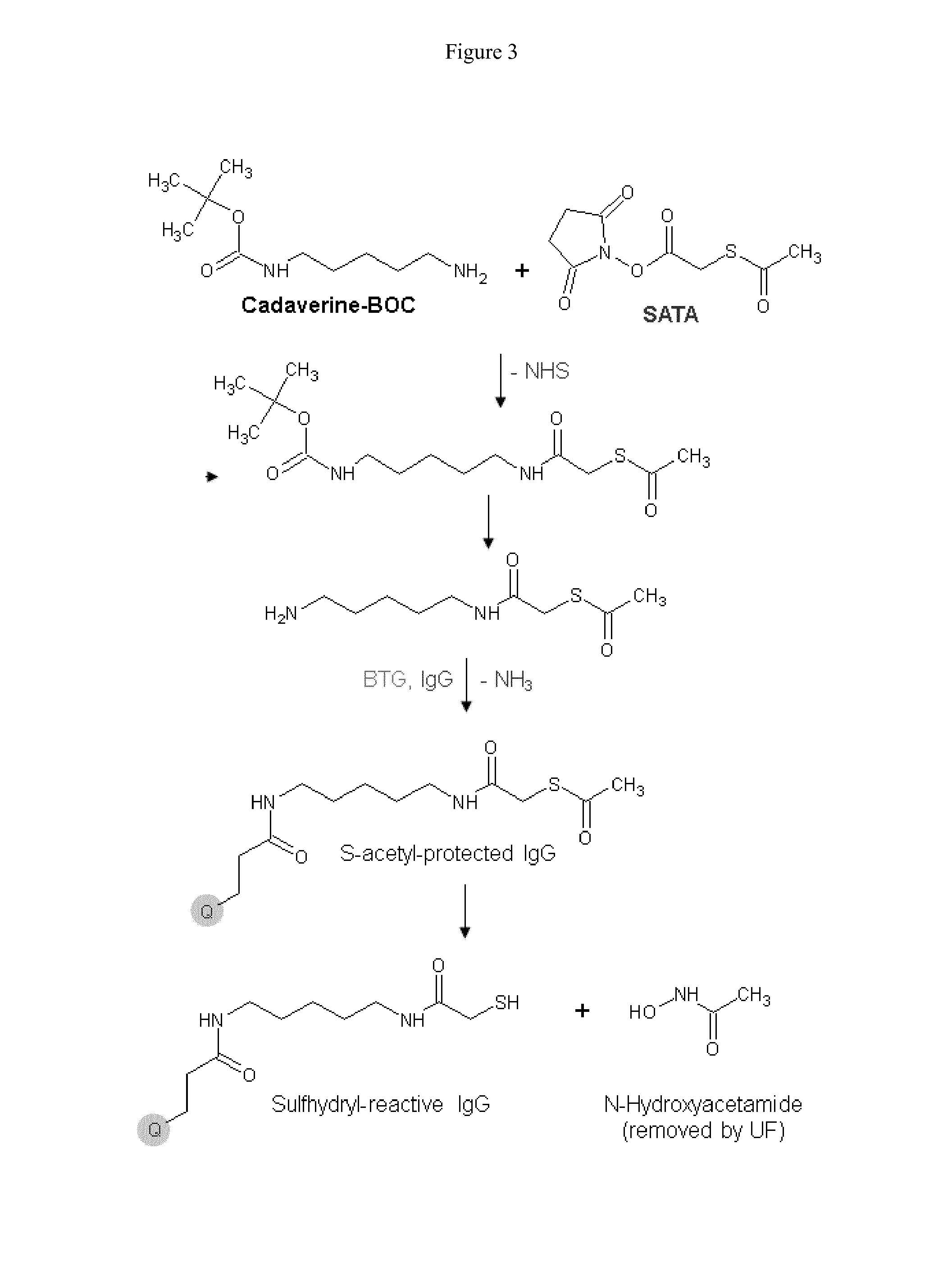Enzymatic conjugation of antibodies
a technology of immunoglobulin and enzyme conjugation, which is applied in the field of human and humanized immunoglobulin functionalization, can solve the problems of substantial engineering of cdrs, unstoichiometric conjugation, and conjugation of unwanted cysteine residues, and achieve the effect of improving pharmacokinetic properties
- Summary
- Abstract
- Description
- Claims
- Application Information
AI Technical Summary
Benefits of technology
Problems solved by technology
Method used
Image
Examples
example 1
Synthesis of New Lysine-Based Linkers with and without Spacer Groups
Materials and Methods
[0485]All solvents used for reactions were purchased as anhydrous grade from Acros Organics (puriss., dried over molecular sieves, H2O254). Spots were visualized with UV light (λ=254 nm) or by staining with anisaldehyde solution or KMnO4 solution and subsequent heating. Chromatographic purification of products was performed using Fluka silica gel 60 for preparative column chromatography.
[0486]Nuclear magnetic resonance (NMR) spectra were recorded in CDCl3, CD3OD or D2O either on a Bruker Av-400 or a Bruker Av-500 spectrometer at room temperature. The measured chemical shifts are reported in δ (ppm) and the residual signal of the solvent was used as the internal standard (CDCl3 1H: δ =7.26 ppm, 13C: δ =77.0 ppm, CD3OD 1H: δ =3.31 ppm, 13C: δ =49.1 ppm, D2O 1H: δ =4.81 ppm). All 13C NMR spectra were measured with complete proton decoupling. Data of NMR spectra are reported as follows: s=singlet, d...
example 2
BTG is Unable to Couple Linkers with Large, Hydrophobic and / or Charged Payloads in Quantitative Fashion to Antibodies
1. Coupling of Dansyl and Biotin Linkers
[0515]The structures of biotin-cadaverin and dansyl cadaverin are shown below.
[0516]Antibody chADC1 having one potential acceptor glutamine on each heavy chain was degycolsylated by PNGaseF treatment and a mass of 48945 Da for unmodified, deglycosylated heavy chain was determined. The light chain remained unaffected (23341 Da found). The coupling reaction (using standard conditions with 1 U / mL BTG) for biotin-cadaverin and dansyl cadaverin was successful however it did not go to completion
[0517]In view of the only partial coupling of biotin-cadaverin and dansyl cadaverin, reaction conditions were explored in an initial step of testing factors influencing reaction conditions. It was found that using 6 U / mL BTG permitted the modification of all heavy chains of PNGaseF-deglycosylated antibody chADC1 was achieved with either exactly...
example 3
Discovery of Optimized Reaction Conditions for BTG
[0526]Despite improvement with spacers, large and / or hydrophobic organic molecules representative of cytotoxic drugs are not able to be coupled by BTG onto acceptor glutamines quantitatively (complete coupling). To explore the possibility that optimized reactions might permit quantitative coupling reaction parameters were explored.
[0527]All the experiments were performed on chADC1 deglycosylated with PNGase F. Antibody concentration was to 1 mg / mL for all experiments. All the experiments were performed using 6 U / mL of BTG. All reactions were monitored by HIC analysis and LC-MS. Samples for HIC analysis were taken after time periods and directly injected in HIC. Samples for MS analysis were frozen to stop the reaction.
[0528]First, the effect of enzyme concentrations was investigated. FIG. 18A depicts the labeling of chADC1 at different concentrations of BTGase. Higher labeling yields were achieved with increasing enzyme concentrations...
PUM
| Property | Measurement | Unit |
|---|---|---|
| structure | aaaaa | aaaaa |
| physical | aaaaa | aaaaa |
| length | aaaaa | aaaaa |
Abstract
Description
Claims
Application Information
 Login to View More
Login to View More - R&D
- Intellectual Property
- Life Sciences
- Materials
- Tech Scout
- Unparalleled Data Quality
- Higher Quality Content
- 60% Fewer Hallucinations
Browse by: Latest US Patents, China's latest patents, Technical Efficacy Thesaurus, Application Domain, Technology Topic, Popular Technical Reports.
© 2025 PatSnap. All rights reserved.Legal|Privacy policy|Modern Slavery Act Transparency Statement|Sitemap|About US| Contact US: help@patsnap.com



